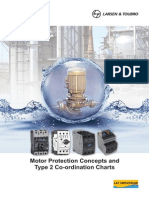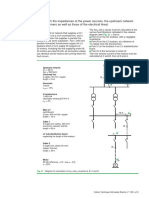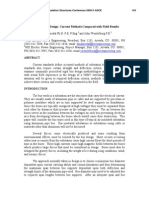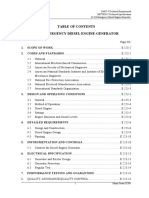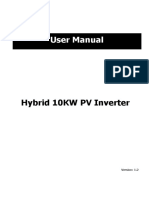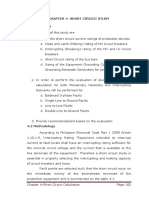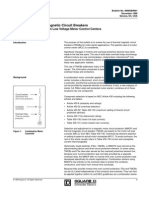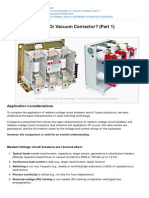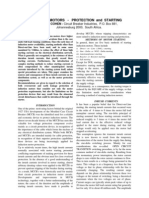Data Bulletin: Benefits of Thermal Magnetic Circuit Breakers
Data Bulletin: Benefits of Thermal Magnetic Circuit Breakers
Uploaded by
amitbharadwaj7Copyright:
Available Formats
Data Bulletin: Benefits of Thermal Magnetic Circuit Breakers
Data Bulletin: Benefits of Thermal Magnetic Circuit Breakers
Uploaded by
amitbharadwaj7Original Title
Copyright
Available Formats
Share this document
Did you find this document useful?
Is this content inappropriate?
Copyright:
Available Formats
Data Bulletin: Benefits of Thermal Magnetic Circuit Breakers
Data Bulletin: Benefits of Thermal Magnetic Circuit Breakers
Uploaded by
amitbharadwaj7Copyright:
Available Formats
Bulletin No.
8998DB9901
December 1999
Seneca, SC, USA
Data Bulletin
Benefits of Thermal Magnetic Circuit Breakers
For Combination Starters in Low Voltage Motor Control Centers
Class 8998
The purpose of this bulletin is to review the use of thermal magnetic circuit
breakers (TMCBs) for motor starter applications. The specific case of a motor
control center (MCC) is considered.
Introduction
Significant changes in motors and overload protective devices have been
made in the last few years. The use of solid state overload relays and energy
efficient motors are now commonplace. Underwriters Laboratories (UL)
requirements and the National Electric Code (NEC) are changing to reflect
these new application realities.
The use of TMCBs addresses many of these application and standards
issues. The information presented is based on Square D circuit breakers,
overload relays and contactors.
Background
A combination motor controller applied in a UL 845 Listed motor control
center includes a disconnect, short circuit or ground fault protective device,
a controller, and thermal overload protection (see Figure 1). These functions
can be provided by separate devices or combined. In fact, a new category of
starter (UL 508e Listed self-protected motor starter) combines all of these
functions into one component.
Circuit breaker
(Disconnect and
short circuit protection)
Component selection is based on NEC Article 430 including the following
articles and tables:
Contactor
Article 430-32 (overload selection)
Article 430-6 (ampacity and ratings)
(Controller)
Article 430-52; Table 430-152 (maximum setting of branch circuit
protective devices)
Overload relay
Article 430-110a (disconnect rating)
(Thermal overload
protection)
Table 430-150 (motor full load currents)
M
Figure 1:
Combination Motor
Controller
Table 430-151 (motor locked rotor currents).
Selection and adjustment of a magnetic motor circuit protector (MMCP) and
thermal magnetic circuit breaker (TMCB) are based on the motor full load
currents (MFLC) from NEC Table 430-150. Overload trip element selection
or setting is based on actual motor nameplate MFLC. To avoid confusion, the
rest of the article usually refers to Table 430-150 current and nameplate
current interchangeably.
Historically, fused switches (FSs), TMCBs, or MMCPs have served as the
disconnecting device and short circuit protective element. In some cases,
TMCBs and FSs have also served as the overload protective element but,
because over current protection was normally provided by a separate
overload relay, the MMCP with no inverse time over current protection was
developed specifically for starter applications. Combination starters using
MMCPs rely entirely on the overload relay to protect the contactor,
conductors, and motor from inverse time overloads.
Because they provide inverse time over current protection, FSs and TMCBs
can be UL Listed independently of the contactor and overload. They can then
be applied together (within UL and NEC guidelines) as a combination starter
1999 Square D All Rights Reserved
Benefits of Thermal Magnetic Circuit Breakers
Data Bulletin
Bulletin No. 8998DB9901
December 1999
without additional testing. MMCPs must be UL Listed as part of a
combination motor controller including the overload relay.
The overload relay included thermal elements that could be tailored
specifically to the motor load. Thermal elements were usually the melting
alloy type. Bimetallic elements were used for applications requiring ambient
compensation.
Because most motors had locked rotor currents of about 600%, overload
class was defined as the maximum time that an overload would pass 600%
of its rating. Class 20 overload relays became the default overload selection,
although Class 10 and Class 30 overload relays were common. A Class 20
overload relay must trip eventually at 100% of its trip rating; in less than 8
minutes at 200%; and in less than 20 seconds at 600% (see Figure 2).
1000
Class 30 OL
Class 20 OL
Class 10 OL
Time in Seconds
100
10
1
10
100
1000
Current in Amperes
Figure 2:
Overload Trip Classes
Interestingly, a variance is allowed. The trip time is shown as an uncertainty
range. To the left of the range, the overload will not trip. In the range, the
overload may trip. To the right of the range, the overload will always trip. The
rating of the overload is typically 125% of motor full load current for a 1.15
service factor motor.
Changing Application
Requirements
Since the energy conservation movement in the late 1970s improving electric
motor efficiency has been a primary goal for motor manufacturers. Energy
efficient motors employ design features that result in a higher X/R
(impedance / resistance) ratios than older standard efficiency designs.
Although these motors have lower motor full load currents (MFLC) than their
predecessors, their potentially higher motor locked rotor currents (MLRC)
and inrush characteristics can result in nuisance tripping of magnetic motor
circuit protectors (MMCPs) set to the 13 X MFLC maximum allowed in the
1999 Square D All Rights Reserved
Bulletin No. 8998DB9901
December 1999
Benefits of Thermal Magnetic Circuit Breakers
Data Bulletin
1996 (and 1999) NEC (Article 430-52). Trip tolerance on an MMCP is -20%/
+30% of the circuit breaker setting. A circuit breaker with a setting equivalent
to 13X MFLC may trip at 10 X MFLC and still be in tolerance.
With the advent of the Energy Policy Act of 1992, and its 1997 target
implementation date, efficiency is now a concern for the majority of industrial
applications. A new type of motor (Design E) has been defined with betterthan-normal efficiency, but even higher inrush characteristics than previous
designs. In recognition of the new design, the 1996 NEC provided for settings
of up to 17X MFLC for Design E motors.
Design E motors have not yet become common in the marketplace.
Application problems with existing energy efficient designs, however,
continue to be an issue. The 1999 NEC allows the higher 17 X MFLC setting
for current Design B energy efficient motors where lower settings are not
sufficient to start the load. In the last few years NEMA, NEC and UL
standards have all been modified to reflect higher locked rotor currents.
Changing Technology
While the application of motor starting was changing, the technology used for
motor overload protection was evolving also. Widespread use of solid state
overload relays in the 1990s has revolutionized motor protection. Features
such as current unbalance and phase loss protection are standard with
products such as the MOTOR LOGIC solid state overload relay
manufactured by Square D. Application advantages include the elimination
of thermal units (heaters) and ambient insensitivity. Because the
impedance of the overload thermal elements has been removed, units may
operate at lower temperatures or in smaller enclosures.
Time in Seconds
1000
100
Along with these new features have come new requirements. The trip
characteristic of these overload relays may differ from the original melting
alloy class equivalent.
These overload relays do not have elements in the current path and use
internal current transformers (CTs) for current sensing. Figure 3 compares a
solid state overload with the melting alloy equivalent. The variability bands
have been removed for clarity. Note the current transformer saturation point
(indicated with a black dot) on the solid state trip curve.
10
In addition, solid state overload relays may require looping for small
horsepower motors or the use of separate CTs for larger loads.
1
.5
10
Current in Amperes
Class 20 Melting Alloy
Class 20 Solid State
CT Saturation Point
Figure 3:
100
The reduction of overall impedance can reduce the SCCR rating of the MCC
combination starter. High interrupting MMCPs or TMCBs may be required to
maintain the SCCR rating. Current limiting modules may also be available to
extend the SCCR range. This may be an important consideration in retrofits
to existing installations.
The use of thermal magnetic circuit breakers to improve the short circuit
rating or eliminate nuisance tripping associated with energy efficient motors
raises several application questions.
Solid State vs. Melting
Alloy Trip Curves
1999 Square D All Rights Reserved
Benefits of Thermal Magnetic Circuit Breakers
Data Bulletin
The Coordination Question
Bulletin No. 8998DB9901
December 1999
TMCBs with a continuous current rating (CCR) of 100 A or below typically
have a non-adjustable magnetic trip point. A properly adjusted MMCP
may clear specific low-level short circuit conditions faster than the nonadjustable TMCB. The crossover between the overload relay trip curve and
the branch protective trip curve is also affected. These issues are often
misunderstood and some misconceptions exist about the effectiveness of
MMCPs versus TMCBs.
The following scenario appears to be a poor application for a TMCB: a 460 V,
1 hp motor with a full load current of about 2.1 A. From NEC Article 430-110a
and Article 430-52 / Table 430-152, a TMCB must have a CCR at least 1.15 X
MFLC up to a maximum of 2.5 X MFLC. If this requirement does not match
a standard breaker rating, selection of the next available standard breaker
ratings is acceptable.
This is particularly significant for low horsepower applications. A 15 A
TMCB is the lowest standard rating and, therefore, may be used for a load
of less than 1 A. This range would require two to three MMCPs (3, 7 and 15 A
ratings) based on the maximum allowable adjustment of between 8 X and
13 X MFLC (13 X for high efficiency).
For MMCP breakers below 100 A, the magnetic trip point is usually fixed at
about 10 X CCR. The 15 A rating has a higher setting than most at about
30 X CCR (450 A). This implies that our 460 V 1 hp motor with a MFLC of 2.1
A would have a magnetic trip point of more than 200 X MFLC. This may seem
to be an area of concern until you evaluate the equivalent branch circuit.
Keep in mind the branch protective device only provides short circuit
protection. Motor protection is provided by the overload relay.
The protected circuit has a NEMA Size 1 contactor and a #12 AWG
conductor (the smallest devices used in an MCC and the smallest
recommended power conductor). The #12 AWG conductor is rated for
approximately 25 A depending on insulation type and installation method (20
A according to UL 508 Table 40.2).
Although the voltage level is different, this could be compared to your home
window fan. The fan motor is usually less than 1 hp. The overload is internal
to the motor. The controller is the switch on the fan. The circuit is a #12 AWG
conductor or smaller and the short circuit protection is provided by a 15 or
20 A branch breaker.
1999 Square D All Rights Reserved
Bulletin No. 8998DB9901
December 1999
Benefits of Thermal Magnetic Circuit Breakers
Data Bulletin
1000
Thermal Magnetic
Class 20 OL
100
Magnetic Only
1 hp Motor
Time in Seconds
10
Area of
Reduced
Coordination
0.10
0.01
1
10
100
1000
Current in Amperes
Figure 4:
Thermal Magnetic vs. Magnetic Only 1 HP at 460 V
Figure 4 shows the coordination curves for this application.
In a 460 V scenario, high-level short circuit fault currents (above 600 A)
should be cleared instantaneously by both a non-adjustable TMCB and
MMCP. Fault currents between 28600 A would be cleared instantaneously
by an MMCP (set to the 13 X NEC standard efficiency limit) but could be
inverse time related for a non-adjustable TMCB. (A fault of 250 A would have
a maximum delay of two seconds.)
In the narrow fault current range between 28600 A, the MMCP limits
thermal and mechanical stress better than a non-adjustable TMCB.
However, the contactor is protected in either case because the overload relay
should not open the contactor above its interrupting rating. Note that
although the crossover may be shifted slightly upward (from 28 to a
maximum of 40 A) the TMCB does not interfere with the normal inverse time
protection of the overload relay.
The short time current carrying and interrupting capacity of a NEMA
contactor is proven during combination starter UL 508 and 845 testing and
NEMA ICS2 qualification. They must interrupt for 10 operations and conduct
for 10 seconds at 10 X the maximum FLC for any starter horsepower or
voltage rating covered by that size contactor.
The maximum current for a NEMA Size 1 contactor occurs in a 7.5 hp, 200 V
starter. (MFLC of 25 A, 10 X 25=250 A). The standards require testing at
250 A and 200 V only; Square D, however, usually tests at 600 V for
convenience. In general, TYPE STM contactors manufactured by Square D
interrupt at least 10 X their maximum continuous current at 600 V (in this
case 270 A). Generically, continuous current rating does not relate to
interrupting ability. Other vendors may elect to test at the minimum voltage
and current levels.
1999 Square D All Rights Reserved
Benefits of Thermal Magnetic Circuit Breakers
Data Bulletin
The Properly Adjusted Key
Bulletin No. 8998DB9901
December 1999
Selection and adjustment of both MMCPs and TMCBs are based on NEC
Table 430-150 full load currents. Some branch protective devices are set in
multiples of the device CCR. This value must be calculated by dividing the
Table 430-150 MFLC by the CCR to determine the proper setting.
Proper overload trip setting is based on actual motor nameplate MFLC and
service factor. Looping for small horsepower motors or the use of separate
CTs for larger loads may require conversion to provide the correct value.
Given the large tolerance band for both the overload (+ 12.5%) and circuit
breaker (-20%/+30%) these settings are Ball Park at best.
Circuit breaker current ratings are usually the same regardless of voltage.
Motor full load currents, on the other hand, vary significantly with voltage. At
some voltages, the allowable NEC adjustment range for a given motor full
load current may not align well with the range of standard circuit breakers.
This is true especially if the allowable range is extended to 17 X MFLC. In
these cases, more than one circuit breaker may be required to cover the full
NEC allowable range.
De-rating, which is sometimes necessary as a result of ambient temperature
or altitude, will affect the overload, circuit breaker, and conductors differently.
Proper adjustment of devices in these conditions can be difficult. When
equipment is shipped from the factory, the settings are usually at the
minimum level, as the actual full load currents are not known.
Sub-contractors are not always precise in their commissioning adjustments.
It may fall to the end user to check all protection settings. Only a detailed
review by a qualified electrician, electrical inspector, or engineer can identify
improperly adjusted applications.
In the worst case scenario, the MMCP may be set to the maximum value to
complete subsystem check-out during commissioning. If the protective
device is not subsequently adjusted correctly, a significant gap in protection
may go undetected until a problem results. Many MMCP and MFLC
combinations would allow settings of 25 X MFLC and higher if set to their
maximum trip point.
The NEMA Size 1 contactor mentioned on page 5 is a good example of this.
This time, the contactor is applied in a 10 hp, 480 V, NEMA Size 1 starter with
a full load current of 14 A. An MMCP rated at 30 A is used typically (a 15 A
MMCP does not meet the 1.15 X MFLC criteria in NEC 430-110a). As
determined previously, the maximum tested contactor interrupting and
withstand current is 250 A.
The 30 A MMCP maximum setting is about 350 A (25 X MFLC), but includes
the +30% allowable UL tolerance. If the +30% allowable UL tolerance is
provided, the MMCP breaker might not trip until 455 A (32 X MFLC) (see
Figure 5 on page 7). In this case, an incorrectly adjusted MMCP could allow
the contactor to open above its tested rating in the low-level fault band
between 250 and 455 A.
1999 Square D All Rights Reserved
Bulletin No. 8998DB9901
December 1999
Benefits of Thermal Magnetic Circuit Breakers
Data Bulletin
1000
Thermal Magnetic
Class 20 OL
100
Magnetic Only
Time in Seconds
10 hp Motor
10
1
Area of
Improved
Coordination
0.10
0.01
10
100 250
450 1000
Current in Amperes
Figure 5:
Thermal Magnetic vs. Improperly Adjusted Magnetic Only
10 HP at 460 V
A 25 A TMCB would be selected for this application. The TMCB provides a
nominal fixed instantaneous trip point of 438 A (600 A at the +20%
tolerance). The inverse time trip characteristic of a TMCB provides protection
between the instantaneous trip point and the overload relay trip curve. In this
case, the TMCB inverse time protection would clear low level faults before
the overload relay attempted to open the contactor (At 250 A the TMCB
would open in less than 3 seconds) (see Figure 5).
Similar results occur for 20 and 30 hp ratings. For these ratings the TMCB
provides some back-up protection for an improperly adjusted overload relay
without interfering with the normal inverse time protection of the properly
adjusted one. Contactor protection is not dependent on TMCB adjustment as
is the case with an MMCP.
Conclusion
In general TMCBs have distinct advantages in the range under 100 A:
NEC code compliance is not dependent on circuit breaker setting or
adjustment (<100 A).
Significant reduction in nuisance tripping associated with high in-rush
applications
Wide application range under 15 A
Possible back-up overload protections against improper adjustment,
contact weld or control circuit failure
Common spares with general branch circuits
High short circuit current rating (SCCR)
1999 Square D All Rights Reserved
Benefits of Thermal Magnetic Circuit Breakers
Data Bulletin
Bulletin No. 8998DB9901
December 1999
Because most MCC applications are under 100 A, the majority of starter units
using TMCBs will not require adjustment of the magnetic trip point for short
circuit protection. In many of these applications a TMCB will provide some
degree of backup protection for improperly adjusted overload relays or
control system faults.
Although the protection crossover is shifted, TMCBs will not usually interfere
with the normal inverse time protection of a properly adjusted overload relay.
The advantages of TMCBs are particularly valuable in the following higinrush applications:
Where a transformer is switched as part of the motor circuit such as an
autotransformer starter
Where high efficiency motors are likely to be used and motor data is not
available
For use with Design E motors
Where unusual application conditions are expected such as voltage
fluctuations or extremely low power factor
With CT rated overload relays and high available fault current
TMCBs above 100 A (used in NEMA Size 4 starters and larger) usually have
an adjustable magnetic trip point similar to MMCPs. The setting is typically
adjustable from 5 to 10 X the TMCB continuous current rating (CCR). In
general, the adjustment range corresponds to values from 8 X to 14 X MFLC.
Because the instantaneous trip point is dependent on the magnetic setting,
the coordination of a TMCB and an MMCP in this range is similar.
References and Recommended
Reading
The following is a list of references and recommended reading. These will
help you gain a wider perspective of the industry standards and technological
advances that have driven the evolution of thermal magnetic circuit breakers
for combination motor starters.
References
ANSI/UL 508-1993; American National Standards Institute; Underwriters
Laboratories; Industrial Control Equipment
ANSI/UL 845-1997; American National Standards Institute; Underwriters
Laboratories; Motor Control Centers
ANSI/NEC 70, 1999; American National Standards Institute; National
Fire Protection Association, National Electric Code; Quincy, MA
ANSI/NEC ICS2, 1993; American National Standards Institute; National
Electric Manufacturers Association, Industrial Control Standards;
Washington DC
Square D Digest 171, 1997; Square D Company, Palatine, IL
Recommended Reading
IAS Meeting Article, 1998; Application Guidelines for Instantaneous Trip
Circuit Breakers in Combination Motor Starters; George Gregory and
Lorraine K. Padden
IEEE Applications Magazine, Institute of Electrical and Electronics
Engineers, January/February 1997; Short Circuit Protection of Energy
Efficient Motors; by Dennis Heath and H.L Bradfield
1999 Square D All Rights Reserved
Bulletin No. 8998DB901
December 1999
Square D Company
1990 Sandifer Blvd.
Seneca, SC 29678 USA
1-888-Square D (1-888-778-2733)
www.squared.com
1999 Square D All Rights Reserved
Benefits of Thermal Magnetic Circuit Breakers
Data Bulletin
Electrical equipment should be serviced only by qualified electrical maintenance personnel. No
responsibility is assumed by Square D for any consequences arising out of the use of this material.
Bulletin No. 8998DB9901 1999 Square D.
You might also like
- Fiat 128 Service Manual: - PDF - 239.66 - 23 Sep, 2013No ratings yetFiat 128 Service Manual: - PDF - 239.66 - 23 Sep, 20133 pages
- Awards and Decorations of The Philippine National Police88% (26)Awards and Decorations of The Philippine National Police2 pages
- (BS EN 62086-1-2005) - Electrical Apparatus For Explosive Gas Atmospheres. Electrical Resistance Trace Heating - General and Testing Requirements PDFNo ratings yet(BS EN 62086-1-2005) - Electrical Apparatus For Explosive Gas Atmospheres. Electrical Resistance Trace Heating - General and Testing Requirements PDF32 pages
- And The Power Supply Transformers As Well As Those of The Electrical Lines)No ratings yetAnd The Power Supply Transformers As Well As Those of The Electrical Lines)15 pages
- Fast Bus Transfer Systems For Critical Process ContinuityNo ratings yetFast Bus Transfer Systems For Critical Process Continuity11 pages
- Order No. 208 of 14.12.2018 - Technical Norm To Connect PGM, PPM and Offs...No ratings yetOrder No. 208 of 14.12.2018 - Technical Norm To Connect PGM, PPM and Offs...175 pages
- Simulation: of Switching Overvoltages of 400 KV Shunt ReactorNo ratings yetSimulation: of Switching Overvoltages of 400 KV Shunt Reactor10 pages
- Protection According To The ANSI - IEEE 946 - Open ElectricalNo ratings yetProtection According To The ANSI - IEEE 946 - Open Electrical8 pages
- Substation Bus Design Current Methods Compared With Field ResultNo ratings yetSubstation Bus Design Current Methods Compared With Field Result10 pages
- D-AAA-TRAFO-ATR-EXP-11 - 200 (Rev.0-2011)No ratings yetD-AAA-TRAFO-ATR-EXP-11 - 200 (Rev.0-2011)7 pages
- E-223 Emergency Diesel Engine-GeneratorNo ratings yetE-223 Emergency Diesel Engine-Generator15 pages
- 1MRG014321 en Practical Experience With Differential Protection For Converter TransformersNo ratings yet1MRG014321 en Practical Experience With Differential Protection For Converter Transformers10 pages
- Performance Testing of A Megawatt-Scale Battery Storage For Energy Trading100% (1)Performance Testing of A Megawatt-Scale Battery Storage For Energy Trading9 pages
- Conductor Size, General: Table C-2 NEC References For Conductor SizingNo ratings yetConductor Size, General: Table C-2 NEC References For Conductor Sizing4 pages
- GE Transformer Management Relay Instruction Manual (Hay)100% (1)GE Transformer Management Relay Instruction Manual (Hay)282 pages
- WECC Approved Dynamic Model Implementation Schedule July 2014 v0No ratings yetWECC Approved Dynamic Model Implementation Schedule July 2014 v02 pages
- Engineering Specification For Ni-CD CellsmodifiedNo ratings yetEngineering Specification For Ni-CD Cellsmodified4 pages
- Comparing Transformer-Free To Transformer-Based UPS DesignsNo ratings yetComparing Transformer-Free To Transformer-Based UPS Designs16 pages
- Emergency Generator Sizing and Motor Starting AnalysisNo ratings yetEmergency Generator Sizing and Motor Starting Analysis6 pages
- Selective Coordination Breaker Application ChartNo ratings yetSelective Coordination Breaker Application Chart5 pages
- 15-Chapter 4 Short Circuit Analysis-Objectives and Methodology100% (1)15-Chapter 4 Short Circuit Analysis-Objectives and Methodology4 pages
- EN - ACS380 Common DC Application Guide - ANo ratings yetEN - ACS380 Common DC Application Guide - A32 pages
- Calculation Methodology For Reactive Power Consumption of Three Winding Transformers in PV Plant 210118No ratings yetCalculation Methodology For Reactive Power Consumption of Three Winding Transformers in PV Plant 2101186 pages
- International Telecommunication Union: RecommendationNo ratings yetInternational Telecommunication Union: Recommendation25 pages
- Modeling of Photovoltaic Systems Using MATLAB: Simplified Green CodesFrom EverandModeling of Photovoltaic Systems Using MATLAB: Simplified Green CodesNo ratings yet
- Renewable Energy Tariffs and Incentives in Indonesia: Review and RecommendationsFrom EverandRenewable Energy Tariffs and Incentives in Indonesia: Review and RecommendationsNo ratings yet
- Grid-Integrated and Standalone Photovoltaic Distributed Generation Systems: Analysis, Design, and ControlFrom EverandGrid-Integrated and Standalone Photovoltaic Distributed Generation Systems: Analysis, Design, and ControlNo ratings yet
- MV Circuit Breaker or Vacuum Contactor Part 1No ratings yetMV Circuit Breaker or Vacuum Contactor Part 12 pages
- Reduce Standby Power Drains With Ultra-Low-Current, Pulse-Frequency-Modulated (PFM) DC-DC ConvertersNo ratings yetReduce Standby Power Drains With Ultra-Low-Current, Pulse-Frequency-Modulated (PFM) DC-DC Converters8 pages
- The Design Basics of Motor Protection Circuit Breaker - EEPNo ratings yetThe Design Basics of Motor Protection Circuit Breaker - EEP12 pages
- Tsewg Tp-11 Ufc 3-500-10n Best PracticesNo ratings yetTsewg Tp-11 Ufc 3-500-10n Best Practices7 pages
- LCIs and Syn Motors Applied To Roller Mills - Zayechek - 2000No ratings yetLCIs and Syn Motors Applied To Roller Mills - Zayechek - 200010 pages
- International Journal On Commerce and ManagementNo ratings yetInternational Journal On Commerce and Management12 pages
- FM Assignment - EVA and DuPont Analysis For CompaniesNo ratings yetFM Assignment - EVA and DuPont Analysis For Companies10 pages
- Augmented Reality - Ishika - PDF - Ishika ShrutiNo ratings yetAugmented Reality - Ishika - PDF - Ishika Shruti16 pages
- Id Product N Product Tystatus Registered Manufactutotal Scor Epeat Tierregisteredarchived ONo ratings yetId Product N Product Tystatus Registered Manufactutotal Scor Epeat Tierregisteredarchived O123 pages
- Beyond The Scalpel - Understanding Acute Kidney Problems After HeaNo ratings yetBeyond The Scalpel - Understanding Acute Kidney Problems After Hea15 pages
- Python-Programming-Exercises - 100+ Python Challenging Programming Exercises100% (2)Python-Programming-Exercises - 100+ Python Challenging Programming Exercises33 pages
- Porter's Generic Strategies: Cost Leadership DifferentiationNo ratings yetPorter's Generic Strategies: Cost Leadership Differentiation5 pages
- Physical and mechanical properties of calcareoNo ratings yetPhysical and mechanical properties of calcareo18 pages
- 130 CÂU HỎI ÔN TẬP P5 TOEIC BK -THUYTOEIC (1) -đã chuyển đổiNo ratings yet130 CÂU HỎI ÔN TẬP P5 TOEIC BK -THUYTOEIC (1) -đã chuyển đổi9 pages
- Comparison of Surgical and Medical Therapy For Type 2 Diabetes in Severely Obese AdolescentsNo ratings yetComparison of Surgical and Medical Therapy For Type 2 Diabetes in Severely Obese Adolescents9 pages
- Break Even - Fixed and Variable Expenses Student Worksheet NameNo ratings yetBreak Even - Fixed and Variable Expenses Student Worksheet Name3 pages
- MSEDCL Approved Vendor List (All Schemes) - RMUNo ratings yetMSEDCL Approved Vendor List (All Schemes) - RMU3 pages
- User's Guide: For Power Distribution Unit (PDU) in ION™ Optical Master UnitNo ratings yetUser's Guide: For Power Distribution Unit (PDU) in ION™ Optical Master Unit8 pages
- PLANMECA PROSTYLE COMPACT Manual de UtilizadorNo ratings yetPLANMECA PROSTYLE COMPACT Manual de Utilizador86 pages
- Fiat 128 Service Manual: - PDF - 239.66 - 23 Sep, 2013Fiat 128 Service Manual: - PDF - 239.66 - 23 Sep, 2013
- Awards and Decorations of The Philippine National PoliceAwards and Decorations of The Philippine National Police
- (BS EN 62086-1-2005) - Electrical Apparatus For Explosive Gas Atmospheres. Electrical Resistance Trace Heating - General and Testing Requirements PDF(BS EN 62086-1-2005) - Electrical Apparatus For Explosive Gas Atmospheres. Electrical Resistance Trace Heating - General and Testing Requirements PDF
- And The Power Supply Transformers As Well As Those of The Electrical Lines)And The Power Supply Transformers As Well As Those of The Electrical Lines)
- Fast Bus Transfer Systems For Critical Process ContinuityFast Bus Transfer Systems For Critical Process Continuity
- Order No. 208 of 14.12.2018 - Technical Norm To Connect PGM, PPM and Offs...Order No. 208 of 14.12.2018 - Technical Norm To Connect PGM, PPM and Offs...
- Simulation: of Switching Overvoltages of 400 KV Shunt ReactorSimulation: of Switching Overvoltages of 400 KV Shunt Reactor
- Protection According To The ANSI - IEEE 946 - Open ElectricalProtection According To The ANSI - IEEE 946 - Open Electrical
- Substation Bus Design Current Methods Compared With Field ResultSubstation Bus Design Current Methods Compared With Field Result
- 1MRG014321 en Practical Experience With Differential Protection For Converter Transformers1MRG014321 en Practical Experience With Differential Protection For Converter Transformers
- Performance Testing of A Megawatt-Scale Battery Storage For Energy TradingPerformance Testing of A Megawatt-Scale Battery Storage For Energy Trading
- Conductor Size, General: Table C-2 NEC References For Conductor SizingConductor Size, General: Table C-2 NEC References For Conductor Sizing
- GE Transformer Management Relay Instruction Manual (Hay)GE Transformer Management Relay Instruction Manual (Hay)
- WECC Approved Dynamic Model Implementation Schedule July 2014 v0WECC Approved Dynamic Model Implementation Schedule July 2014 v0
- Comparing Transformer-Free To Transformer-Based UPS DesignsComparing Transformer-Free To Transformer-Based UPS Designs
- Emergency Generator Sizing and Motor Starting AnalysisEmergency Generator Sizing and Motor Starting Analysis
- 15-Chapter 4 Short Circuit Analysis-Objectives and Methodology15-Chapter 4 Short Circuit Analysis-Objectives and Methodology
- Calculation Methodology For Reactive Power Consumption of Three Winding Transformers in PV Plant 210118Calculation Methodology For Reactive Power Consumption of Three Winding Transformers in PV Plant 210118
- International Telecommunication Union: RecommendationInternational Telecommunication Union: Recommendation
- Modeling of Photovoltaic Systems Using MATLAB: Simplified Green CodesFrom EverandModeling of Photovoltaic Systems Using MATLAB: Simplified Green Codes
- Renewable Energy Tariffs and Incentives in Indonesia: Review and RecommendationsFrom EverandRenewable Energy Tariffs and Incentives in Indonesia: Review and Recommendations
- Grid-Integrated and Standalone Photovoltaic Distributed Generation Systems: Analysis, Design, and ControlFrom EverandGrid-Integrated and Standalone Photovoltaic Distributed Generation Systems: Analysis, Design, and Control
- Reduce Standby Power Drains With Ultra-Low-Current, Pulse-Frequency-Modulated (PFM) DC-DC ConvertersReduce Standby Power Drains With Ultra-Low-Current, Pulse-Frequency-Modulated (PFM) DC-DC Converters
- The Design Basics of Motor Protection Circuit Breaker - EEPThe Design Basics of Motor Protection Circuit Breaker - EEP
- LCIs and Syn Motors Applied To Roller Mills - Zayechek - 2000LCIs and Syn Motors Applied To Roller Mills - Zayechek - 2000
- FM Assignment - EVA and DuPont Analysis For CompaniesFM Assignment - EVA and DuPont Analysis For Companies
- Id Product N Product Tystatus Registered Manufactutotal Scor Epeat Tierregisteredarchived OId Product N Product Tystatus Registered Manufactutotal Scor Epeat Tierregisteredarchived O
- Beyond The Scalpel - Understanding Acute Kidney Problems After HeaBeyond The Scalpel - Understanding Acute Kidney Problems After Hea
- Python-Programming-Exercises - 100+ Python Challenging Programming ExercisesPython-Programming-Exercises - 100+ Python Challenging Programming Exercises
- Porter's Generic Strategies: Cost Leadership DifferentiationPorter's Generic Strategies: Cost Leadership Differentiation
- 130 CÂU HỎI ÔN TẬP P5 TOEIC BK -THUYTOEIC (1) -đã chuyển đổi130 CÂU HỎI ÔN TẬP P5 TOEIC BK -THUYTOEIC (1) -đã chuyển đổi
- Comparison of Surgical and Medical Therapy For Type 2 Diabetes in Severely Obese AdolescentsComparison of Surgical and Medical Therapy For Type 2 Diabetes in Severely Obese Adolescents
- Break Even - Fixed and Variable Expenses Student Worksheet NameBreak Even - Fixed and Variable Expenses Student Worksheet Name
- User's Guide: For Power Distribution Unit (PDU) in ION™ Optical Master UnitUser's Guide: For Power Distribution Unit (PDU) in ION™ Optical Master Unit





